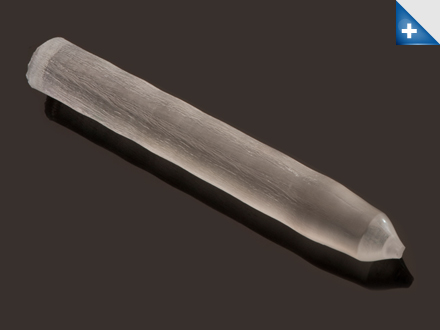
Yttrium Orthosilicate is a monoclinic biaxial crystal belonging to the C2/c (C6 2h) space group. Rare earth ions substitute for the Y3+ ions which occupy two crystallographic sites of C1 symmetry. Emission and absorption spectra for rare earth dopants are polarized and generally have higher cross-sections when compared to YAG.
Crystals of Y2SiO5 are available with a variety of dopant ions including Ce, Pr, Nd, Eu, Tb, Ho, Er, Tm, Tm:Ho, and Cr.
Eu3+ and Er3+ activated YSO exhibit very narrow homogeneously broadened absorption line widths (sub kHz), embedded within a broader (∼GHz) inhomogeneously broadened line, when cooled to cryogenic temperatures. Er3+:YSO was shown to have a homogeneous optical resonance width of only 73 Hz, the narrowest atomic resonance observed in any solid state material[1].
Rare-earth activated YSO materials are of significant interest to applications including:
In general, Y2SiO5 is not as robust a material as YAG but is 10-20‰ stronger than YLF. It has a damage threshold of > 10 J/cm2 for 10 ns pulses at 10 Hz which is comparable to that of YAG. The thermophysical properties of Y2SiO5 have been studied by researchers at Lawrence Livermore National Laboratory[8]. Because of its natural birefringence, Y2SiO5 does not exhibit thermally induced stress birefringence.
Note that SM uses the coordinate axis naming convention described in[9], where b, D1 and D2 describe the 3 principle axis of polarization. Other references (3 for example) use an x, y, z coordinate system, corresponding to the b, D1 and D2 axis respectively.
Contact us with your specific requirements or for availability and pricing of currently stocked compositions and concentrations.
| Coefficient of Thermal Expansion [8] | 7.4 x 10-6 ϒC-1 (a) |
| 7.4 x 10-6 ϒC-1 (b) | |
| 5.2 x 10-6 ϒC-1 (c) | |
| Thermal Diffusivity[8] | 0.030 cm2 s-2 |
| Thermal Conductivity [8] | 4.49 W m-1 K-1 (a) |
| 4.60 W m-1 K-1 (b) | |
| 4.08 W m-1 K-1 (c) | |
| Specific Heat (Cp) [8] | 0.646 J g-1 K-1 |
| Thermal Shock Resistant | |
| Refractive Index @ 632.8 nm | 1.782(a) |
| 1.785(b) | |
| 1.806(c) | |
| Molecular Weight | 2.85.9 g mol-1 |
| Melting Point | 2070°C |
| Density | 4.44 g cm-3 |
| Crystal Structure | Monoclinic |
| Standard Orientation | D1, D2, or b-axis |
| Y3+ Site Symmetry | Two Sites - C1 |
| Lattice Constant | a=12.50 Å |
| a=6.73 Å | |
| a=10.42 Å | |
| β=102.68° |
1) T. Bottger, et al., Phys. Rev. B 79, 115104 (2009), and for similar work in Eu:YSO see R.W. Equall, et. al., Phys. Rev. Lett. 72, 2179 (1994)
2) Thomas Bõttger, et al., Proceedings of SPIE , Vol. 4988, 51-61 (2003).
3) Lauritzen et al., Phys. Rev. Lett. 104, 080502 (2010).
4) Z. Cole, et al., Appl. Phys. Lett. 81, 3525-3527 (2002).
5) B. Comaskey, et al., "Flashlamp Pumped Laser Operation of Nd:Y2SiO5 at 1.074 Microns", Opt. Lett. 18, 2029 (1993).
6) R. Beach, M. D. Shinn, L. Davis, R. W. Solarz and W. F. Krupke, Optical Absorption and Stimulated Emission of Neodymium in Yttrium Orthosilicate, IEE J.
Quantum Electron. 26, 1405 (1990).
7) C. Li, R. Moncorge, J. C. Souriau, and Ch. Wyon, Efficient 2.05 ?m Room Temperature Y2SiO5:Tm3+ cw laser, Opt. Comm. 101, 356 (1993).
8) 8 J. Marion and R. Beach, Thermophysical Properties of Y2SiO5 (YOS), LRD 90-038, (1990).
9) C. Li, Ch. Wyon, R. Moncorge, "Spectroscopic properties and Fluorescence Dynamics of Er3+ and Yb3+ in Y2SiO5", IEEE JQE 28, 1209 (1992).